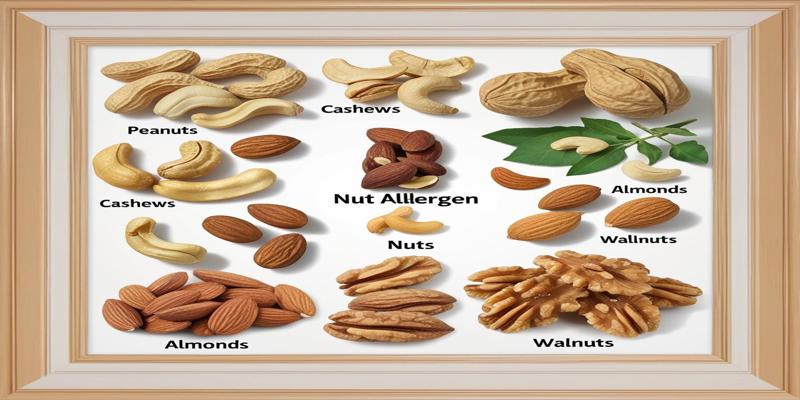Advertisement
Do you or someone you love have a peanut or tree nut allergy? These prevalent food allergies can cause catastrophic reactions and demand careful management. Understanding symptoms, triggers, and treatment options can be significant in living with them.

Peanut and tree nut allergies are the two most common food allergies, affecting millions worldwide. These are allergic reactions in your immune system against certain kinds of proteins in either peanuts or tree nuts, accelerating the allergic reaction. Peanuts are legumes but are often categorized with tree nuts because of their similar allergic responses.
Nut allergies can be broadly categorized into two main types:
Though not fully known, the exact cause of nut allergies can be increased by the following:
Symptoms that manifest in both peanut and nut allergies form the basis of necessary recognition for timely intervention and management. These allergic reactions can range from mild discomfort to life-threatening situations, and awareness is essential both for the individual allergic and his environment.
Skin symptoms are the most frequent manifestations of nut and peanut allergy. You can feel hives that appear as a circumscribed, raised, itchy well that may be as small as a pinpoint or as big as a thumbnail. These can spread to different parts of the body. Moreover, several individuals present with eczema flare-up or generalized redness and skin irritation after nut or peanut exposure.
Allergic reactions can significantly impact your respiratory system. You might experience difficulty breathing, wheezing, or a tight feeling in your chest. Sometimes, you may develop a runny or stuffy nose, like hay fever symptoms. Coughing and throat irritation are also joint, potentially leading to more severe issues like asthma attacks in susceptible individuals.
When allergic to peanuts and nuts, the gastrointestinal system can also be affected, including nausea, stomach ache, or even vomiting within a short period of taking or coming into contact with them. Diarrhea is another symptom that can set in and result in dehydration if not well handled.
In extreme cases, the allergic reaction to peanuts and nuts can also lead to anaphylaxis, a life-threatening reaction. Anaphylaxis involves symptoms such as swelling of the throat and tongue, difficulty swallowing, dizziness, and, eventually, a drop in blood pressure. This condition requires immediate treatment because if it is not quickly treated with epinephrine, it can be fatal.

Accurately diagnosing peanut and nut allergies is important for adequately managing and avoiding life-threatening reactions. Diagnosis often involves combining various methods to ensure an accurate diagnosis.
Your doctor will begin with an in-depth history and physical medical examination, paying close attention to your symptoms, their timing, and possible triggers. Questions about a family history of allergy will be asked, and detailed questions regarding diet and lifestyle will be addressed. A complete physical examination may be performed to detect signs of allergic reactions.
Skin prick tests are among the most prevalent diagnostic tools for peanut and nut allergies. During the test, a small amount of the allergen is placed on your skin and gently pricked. Within 15-20 minutes, a small, itchy bump, known as wheal, should appear if you're allergic. Quick and generally painless, skin prick tests occasionally yield false positives.
Specific IgE (sIgE) blood tests measure the levels of antibodies your immune system produces in response to particular allergens. These tests can be beneficial when skin prick tests aren't feasible or results are unclear. However, like skin prick tests, blood tests can sometimes indicate an allergy when one doesn't exist.
In some cases, your allergist may recommend an oral food challenge. This test involves consuming small amounts of a suspected allergen and gradually increasing the quantity under careful medical supervision. Though it carries some risks, it is considered the gold standard for confirming or ruling out a food allergy. Oral food challenges are precious when other test results are inconclusive or when determining whether a child has outgrown an allergy.
Advanced diagnostic techniques, such as component-resolved diagnostics (CRD), provide further detail on specific proteins in peanuts and tree nuts to which you may be allergic. This will help predict the severity of any reactions and assist in managing the allergy.
Avoidance is the cornerstone of managing peanut and nut allergies. This means carefully reading food labels, being aware when eating out and educating family members and caregivers regarding the condition. Always read ingredient lists carefully, even for previously eaten foods, because manufacturers may sometimes change recipes. When eating in restaurants, inform restaurant staff about your allergy and enquire about possible cross-contamination.
Despite your best efforts, accidental exposure can occur. Always carry an epinephrine auto-injector (such as an EpiPen) and know how to use it. Wear a medical alert bracelet or necklace that identifies your allergy. Create an emergency action plan with your allergist and share it with family, friends, and coworkers.
While there is currently no cure for peanut or tree nut allergies, promising treatments are developing. Oral immunotherapy (OIT) involves gradually introducing small amounts of the allergen under medical supervision to build tolerance. However, it is only recommended for some, and it can be a risky process. A second approach under study is sublingual immunotherapy (SLIT)-placing tiny amounts of allergen under the tongue. Consult an allergist about whether these options might be suitable for you.
Avoiding nuts entirely can also create a deficiency in your diet, as nuts are rich in protein, healthy fat, vitamins, and minerals. Work with a registered dietitian to ensure you have enough of each nutrient from other food sources. Consider different options for healthy fats, such as seeds (if not allergic), avocados, olive oil, legumes, or lean meats for protein.
Understanding peanut and nut allergies is essential for those with the conditions and their loved ones. Symptoms identification, prevention, and being ready for any emergencies are sure ways of effectively managing these life-threatening conditions.
Advertisement

By Vicky Louisa/Mar 17, 2025

By Elva Flynn/Mar 17, 2025

By Celia Shatzman/Nov 06, 2024

By Triston Martin/Feb 28, 2025

By Paula Miller/Jan 24, 2025

By Gabrielle Bennett /Mar 01, 2025

By Sean William/Dec 15, 2024

By Juliana Daniel/Jan 05, 2025

By Maurice Oliver/Nov 06, 2024

By Darnell Malan/Mar 17, 2025

By Pamela Andrew/Mar 17, 2025

By Celia Kreitner/Jan 11, 2025